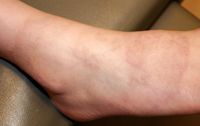Ascending "doughnuts" on a boy's legs
What's causing the "doughnut-shaped bumps" on a boy's legs?
DR. COHEN, who serves as section editor for Dermatology: What's your Dx?, is director, Pediatric Dermatology and Cutaneous Laser Center, and professor of dermatology and pediatrics at Johns Hopkins University School of Medicine. He is a contributing editor for Contemporary Pediatrics. He has nothing to disclose in regard to affiliations with, or financial interests in, any organization that may have an interest in any part of this article.
You are asked to evaluate "doughnut-shaped bumps" on the legs of a 9-year-old boy that have been present since 2 months of age (see the photograph). The asymptomatic eruption has progressed over time from the ankles, up the legs, and onto the hips.
The patient is healthy and active in after-school sports, and does not take any medications.

Diagnosis: Granuloma annulare
Aptly named, the lesions of granuloma annulare (GA) often begin as a dermal papule or nodule that undergoes central involution and gradually expands to form a lumpy ring, 1-to 4-cm in diameter. Some original papules or nodules may still demonstrate a central area of umbilication or depression, and multiple rings may overlap or coalesce to form larger, annular plaques.1 The epidermal skin markings remain intact, but thin overlying scale may develop.
Occasionally, the inflammatory process of GA is confined to fatty tissue, and lesions manifest as firm, rubbery, subcutaneous nodules. Plaques may be skin-colored, but pale erythema or hyperpigmentation may appear, particularly along the border of lesions.
Most lesions of GA are asymptomatic, although some patients complain of minimal pruritus. In children, the most commonly involved areas are the shin, foot, and the scalp-typically, the occiput. Mean age at presentation is 3.9 years.2 More than 40% of cases occur in patients younger than 15 years.3
Diagnosis and differential
Although histologic findings may not be diagnostic, GA is characterized by dermal infiltration of lymphocytes and histiocytes that forms palisading granulomas around abnormal, degenerating collagen.
Subcutaneous lesions occur most often on the extremities and scalp, where they can be fixed to underlying periosteum. Occasionally, subcutaneous lesions occur in concert with more typical superficial lesions, which point to the correct diagnosis.
GA may be confused with the annular plaques of tinea corporis, but tinea triggers a dermatitis with severe pruritus and epidermal changes such as scale, vesicles, and pustules.
Subcutaneous GA can be mistaken for rheumatoid nodules, but the "pseudorheumatoid" nodules of GA are not associated with joint findings.
The small papules of early GA and a variant of GA known as perforating GA, found on the hands and feet of some children, can resemble molluscum contagiosum.4 The course of lesions, lack of symptoms, and, if necessary, skin biopsy allow for confirmation of the diagnosis of GA.
Cause, prognosis
Granuloma annulare may wax and wane for months or years, but lesions disappear without treatment in two years in 50% to 73% of cases.3 Numerous treatments for GA have been proposed, but observation appears most appropriate in children.
Although the etiology of GA is unclear, its association with human immunodeficiency virus (HIV) and hereditary immunodeficiency suggests an aberrant immune response. Chronic relapsing GA and, in adults, generalized GA appear to be strongly associated with both HIV infection and diabetes.5 Most affected children are otherwise normal, however, and their condition does not warrant immunologic or metabolic evaluation.
The course of the disorder in this patient was longer than usual. Thorough physical examination was unremarkable, however, and a decision was made to see him again in six months to evaluate the lesions.
REFERENCES
1. Cohen BA: Pediatric Dermatology (ed 3). New York, N.Y., Elsevier Science, 2005, p138
2. Habif TP: Clinical Dermatology: A Color Guide to Diagnosis and Therapy (ed 4). St. Louis, Mo., Mosby, 2005, p899
3. Hurwitz, S: Clinical Pediatric Dermatology: A Textbook of Skin Disorders of Childhood and Adolescence (ed 2). Philadelphia, Pa., W.B. Saunders, 1993, p404
4. Kapembwa MS, Goolamali SK, Price A, et al: Granuloma annulare masquerading as molluscum contagiosum-like eruption in an HIV-positive African woman. J Am Acad Dermatol 2003;49(2suppl Case Reports):S184
5. Habif TP: Clinical Dermatology: A Color Guide to Diagnosis and Therapy (ed 4). St. Louis, Mo., Mosby, 2005, p644
Please see Dr. Cohen's Web site, http://www.dermatlas.org/, for additional images